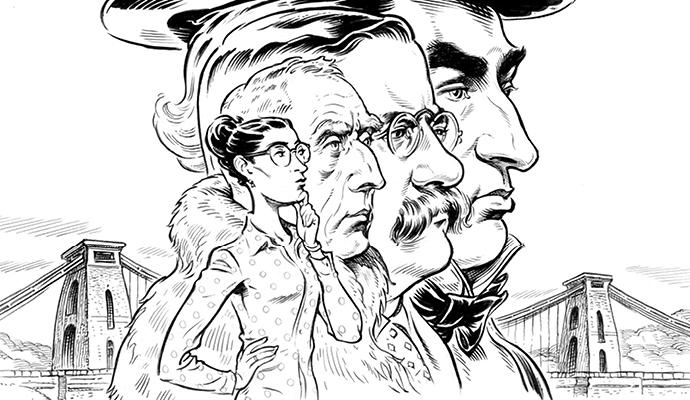Logistical feats
Author and columnist Christopher Mims traces the limits of supply chain technology.
A version of this article appeared in the Spring 2022 issue of strategy+business.
Christopher Mims, a technology columnist at the Wall Street Journal, is one of the leading chroniclers of the increasingly intense and complex tango between humans and the software and hardware that governs their lives as professionals and consumers. In his recent book, Arriving Today: From Factory to Front Door—Why Everything Has Changed About How and What We Buy, he delves deeply into the constellation of issues raised by our long supply chains and continually optimizing logistics functions. These challenges have been thrown into sharp relief not just by the pandemic, but also by a wider understanding of the human costs of the systems that deliver efficiency and delight to consumers. In a conversation with strategy+business, Mims describes how his efforts to trace the path of an object from a factory in Asia to households in the United States raised important questions about the trading systems, managers, employees, and technology that make supply chains work, for better and for worse.
S+B: In Arriving Today, you tell the story of global trade by tracking a hypothetical USB charger from a port in Vietnam to a house in Maryland. But it’s less about trade and more about the link between technology and humans.
MIMS: I did set out to explain the journey of an object from factory to front door. But I couldn’t explain it without describing the peculiar contours of modern supply chains, which are made of humans and machines and are a product of their interaction. They’re interacting in ways that I think are somewhat unique in the 21st century. It provides a lens on how all of work, and especially blue-collar work, is changed by automation.
S+B: You take us through the loading of a ship in Vietnam, steering the massive container ship into a port in California, moving the container through the port and onto a truck, and all the way to fulfillment centers and delivery vans. At some moments, humans are using hardware and software to great effect—someone can steer a giant cargo ship with a tiny dial. But when you get to the fulfillment center, people are at the mercy of hardware and software because they’re being told what to do all the time. How would you describe the dynamic?
MIMS: It’s different at every step. It also depends on who you’re focusing on at every step. The way others have put this is that there are jobs that are either above or below the API, meaning a software application programming interface. Are you using technology and algorithms to make you more effective so you can manage other humans at a greater scale? Or are you one of the humans being managed by those algorithms? If you’re a harbor pilot, arguably, you’re above the API because you’re like a software engineer. Your skills are so valuable and so rare. But if you’re driving for a subcontracted delivery company, you’re definitely below the API. The algorithm is ruling your day.
S+B: A lot of people—even senior executives—don’t think much about supply chains until they stop working. When COVID hit, there were disruptions due to health issues and due to sudden surges in demand for certain products. Are we going to go back to forgetting about supply chains and their importance in our daily lives when things kind of get back to normal?
MIMS: That depends on whether we ever get back to normal. Between the pandemic and persistent labor shortages, the past couple of years were exceptional in that a lot went wrong all at once. But I think in other ways, they were kind of a dry run for future supply shocks and supply chain crises, which can be brought about for any number of reasons. There can be political upheaval. There can be extreme weather. Everybody forgets the volcano that erupted in Iceland and shut down transatlantic air travel in 2010.
These things keep happening. Are they always going to happen on this scale? Maybe not. But I think it’s naive to think that we’re going to return to the before times. What we’re going to return to is a new normal, and it’s not clear what that is going to look like yet.
S+B: Some of the responses to disruptions have involved re-shoring, or moving production closer to consumers, in order to shorten supply chains. In other areas, governments have become involved in building industrial capacity. Is there a systemic rethinking surrounding resilience and redundancy?
MIMS: It depends on the industry. Dual sourcing was a big trend, even before the pandemic—a company like Nike or Adidas saying, “I’m going to make a copy of this factory that is in China in Vietnam, closer to the US, to avoid tariffs,” for example. But there are more reasons. A country can have a water crisis, which forces it to shut down power plants, which forces it to shut down manufacturing. Or there can be a pandemic, or a port can shut down in South Africa because of a cyberattack. So more and more companies are thinking about dual sourcing or multisourcing.
S+B: Your book spends time describing the evolution of industrial organization and optimization—from Frederick Winslow Taylor to Henry Ford, and then to Japanese lean manufacturing. Those all had to do with factories. But as you describe it, we’ve had a step change in the evolution in the realm of e-commerce.
MIMS: Taylorism came about at the beginning of the 20th century. It was the very straightforward realization that if you observed the actions of people working in a factory or some similar context that’s full of work, and you timed all of their actions, you could try to optimize what they did. And from there it spawned every kind of management consulting practice. Henry Ford had his own version. Later on, this becomes the lean manufacturing methods of Toyota and others, which got reimported into the US. And then in the modern day, we add persistent and ubiquitous surveillance by machines, whether those are cameras or the objects that people are working with, like scanner guns used to check things in at warehouses. Once you can observe every single thing that a person is doing in a factory, or a factory-like context—including warehouses, delivery vehicles, and all other points in the supply chain—you can then try to optimize every single action that person is taking and unit of work. You can also do it in a market-based way, if you’re Uber or Lyft, for example.
S+B: Are the problems that have resulted from this—like employee burnout—inevitable? Is it just natural that once you start down the road to optimization, there will always be another penny of margin to gain by pushing people harder?
MIMS: There truly is never anything new under the sun with respect to how humans relate to one another. It’s just that they come up with new mechanisms for relating to one another. So nothing is inevitable. You can create systems of work optimization where people have buy-in and agency. Maybe they’re optimizing their own labor, right? Many of us willingly use productivity hacks and all kinds of ways to make ourselves more effective.
What’s really been interesting about the last two years is that the shortage of labor has given so many workers so much more agency. And that’s why you see companies recognizing that if people feel alienated and dispirited at work, they’re just going to quit. It’s incumbent on management to recognize that simply raising wages truly is not enough, and to really probe the everyday experiences of their workers. Whether people are working in call centers or fast food or warehouses, lots of them feel massively disempowered by being managed by algorithm. And just because there are some people who are OK with that, and the way that it turns work into a game, doesn’t mean that the majority of workers are OK with it—or even that enough of them are.
S+B: In which areas were you surprised by how much work automation is already doing? And in which areas were you surprised by how stubbornly resistant to automation a particular component is?
MIMS: I was very surprised by how automated ports can become. The most advanced ports are able to shrink their physical footprint and increase their throughput in a lot of ways that are impossible without automation. That was truly remarkable to me. And that in turn is enabled by the shipping container. The same thing that made the globalization of finished goods work so well, and that made it so cheap to send them all over the world, has also enabled automation.
I think the areas where I was most impressed that automation was impossible, or very difficult, were inside Amazon warehouses. I mean, this is a company that loves automation. But there are just things that machines truly can’t do. They don’t have the dexterity of humans, and you need humans to make those machines work.
And then, finally, I was deeply impressed by how resistant to automation last-mile delivery is—even to the point that the much-touted route-planning software that companies like UPS have invested so much in is only of limited value. Last-mile delivery is an area where the skill of the human still matters a great deal.
S+B: Going back to the folk story of John Henry competing against the steam drill, there seems to be a recurring theme throughout history of people having to compete against machines and technology. Many key industries, including trucking, have a dichotomy of needing to recruit and retain people while also trying to bring in solutions that might automate their jobs out of existence.
MIMS: I think that’s a very American phenomenon. If you’re a student of the history of automation in places like Japan and Germany, but also South Korea, and even now in China, you can see that it is absolutely possible to use automation to ease people’s burdens, to make their jobs better, to push them into careers that make better use of their creative faculties and that are less repetitive and boring. I think it is in some ways kind of a uniquely, and unfortunately, American attitude and anxiety that automation is always zero-sum with workers, and that the only way that it can be realized is fundamentally dystopian.
I think it is in some ways kind of a uniquely, and unfortunately, American attitude and anxiety that automation is always zero-sum with workers.”
It’s very complicated to unpack why that is. But I think a lot of it comes down to our attitude about who should be in charge and who has agency when automation is put in place. Companies need to recognize that employees should have a say in how the automation that they work with functions. And recognize that that will ultimately lead to lower turnover and probably greater employee satisfaction—and even higher productivity.
Automation doesn’t have to be the enemy. Robots don’t take away people’s jobs; they take over certain tasks. And that means that the kind of work people do changes. If they’re going to be shifted into roles where they’re doing more repetitive work as a result, because they’re like Charlie Chaplin in Modern Times, or Lucille Ball in the famous episode where she works in a chocolate factory, that has to be respected and understood. But it doesn’t always have to look like that.
In Japan, the view of robots is more like Astro Boy, who saves people, but he’s a robot. In the US, going back to the play that gave us the word robot, Rossum’s Universal Robots, we view robots and robotics as a scary and displacing and murderous technology.
S+B: Another feature that keeps cropping up in your book is the presence of algorithms. Algorithms dictate what ads people see; schedule the manufacture of the products they buy; and determine those products’ transport, delivery, and routes to market. Is it the case that we’re at the mercy of algorithms, or that we’re actually all benefiting from them as consumers because they reduce the energy we need to expend making decisions?
MIMS: It tends to be very industry-specific. And I think it’s important to keep in mind the greater historical context. When Charles Dickens wrote Oliver Twist, other than industrialization, none of the things that we’re discussing today even existed. So part of what we’re talking about here is how we use technology to have dominion over one another. And that really determines whether it ends up being ultimately a good or bad thing for people.
I don’t know that algorithms are, themselves, the root of the problems that we have in our labor markets these days. But I do think that management by algorithm facilitates an additional level of remove between management and frontline workers. And whenever you have that, whether it’s a geographic or a communications remove, or in this case abstracting people away through software and scheduling algorithms, there’s a danger that the different layers of an organization just lose touch with one another. And that saps the humanity and the compassion required to run most businesses sustainably in an economy where everyone is an at-will worker and there’s a shortage of workers.
S+B: Having observed the logistics industry from the inside, would you say that the system, broadly speaking, fundamentally works, or that it fundamentally doesn’t work?
MIMS: If you look at trucking, it’s a massively fragmented industry, full of perverse incentives. And if you go into shipping as well, here’s a system where there isn’t enough capacity now, but all of the big shipping companies are making money hand over fist and have very little incentive to take the risks required to make the additional investment to significantly increase capacity. The system is broken in that we are not going to significantly increase capacity in those links of the global supply chain anytime soon. And that may lead to persistent issues that are manifested in inflation and other problems, and fundamentally affect the US and global economies as a result.
S+B: What role does AI play in this?
MIMS: The ultimate test of AI, as it works now, anyway, is fully autonomous trucks and fully autonomous last-mile delivery, and maybe lights-out warehouses. I think we all know by now that autonomous driving has proved more challenging than a lot of folks originally told us it was going to be. AI is fantastic at pattern recognition. It is a great supplement to humans whenever that sort of thing can enhance our work or make us more effective. But the moment that you ask AI to exercise any kind of agency, whether that’s self-driving or the many types of tasks within a warehouse that you need humans to do now, it really just kind of fails.
That’s a commentary on how incredible our brains are after 4 billion years of evolution of life on earth, and on just how far away is this dream of, “Oh, let’s just automate away all the things.” People say we shouldn’t worry about a truck driver shortage because every day we hear about a new startup that’s going to do autonomous long-haul trucking. Ask those startups how many of those robot-driven truck trips they’re taking don’t involve a safety driver. And then ask them when they’re going to take that safety driver out of the cab. All of that stuff is much harder than we thought it was going to be. The ultimate message is that the fact that supply chains are labor-intensive isn’t going to change.





